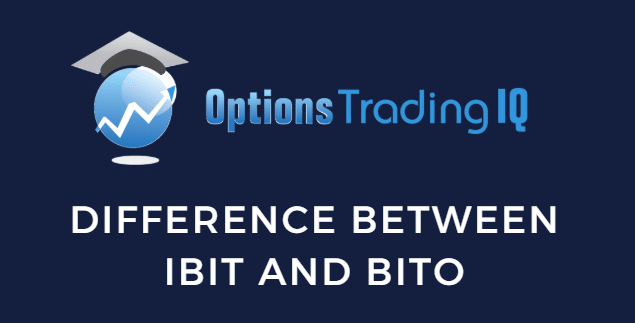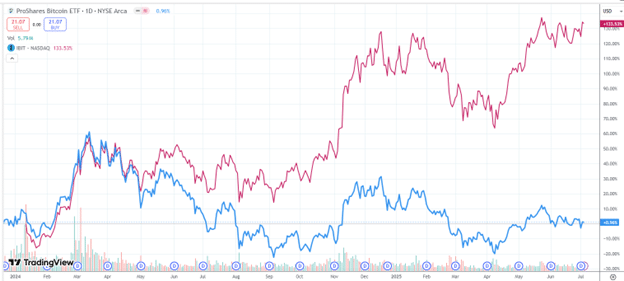
IBIT and BITO are both ETFs that allow investors to gain exposure to Bitcoin, a cryptocurrency asset.
ETFs are attractive because they allow investors to hold cryptocurrency in their portfolios without needing a cryptocurrency exchange account or wallet.
They just need a brokerage account.
Contents
IBIT is a Bitcoin Trust issued by iShares and launched in January 2024.
BITO is issued by ProShares and launched in 2021.
IBIT more closely matches Bitcoin spot prices because it actually owns Bitcoin in the trust.
BITO tracks Bitcoin Futures contracts and does not actually own the Bitcoin asset.
As such, it is subject to tracking error.
While this is minimal for short-term and intraday traders holding BITO in terms of days, BITO is likely to underperform the Bitcoin spot price over the long term due to futures roll costs and contango.
A chart comparison will show that BITO underperforms IBIT:

The red line is IBIT, and the blue line is BITO.
However, this does not take into account the incredibly large dividend payout of BITO.
IBIT does not pay any dividends.
BITO pays a monthly dividend that fluctuates a lot.
As of this writing, the last BITO payout was July 8, 2025, at $0.777 per share.
With BITO share trading at $21, that yields a 3.7% return for that month.
That is a large dividend.
Since the dividend varies from month to month, a better way is to get the dividends for the trailing twelve months:
July 2025: $0.777
June 2025: $0.997
May 2025: $0.545
April 2025: $0.361
March 2025: $0.72
February 2025: $0.937
January 2025: $1.113
December 2024: $0.996
November 2024: $0.994
October 2024: $1.091
September 2024: $1.209
August 2024: $1.447
Total Dividends for trailing twelve months: $11.187
Annual dividend yield for trailing twelve months: 53%
Suppose an investor invested $1000 in BITO on July 31, 2024 (just before the ex-dividend date to pick up the August dividend).
He buys 43 shares at $22.90 per share.
By July 3, 2025, the investment would have grown to $ 1,387.05.
Because:
43 shares at $21.07 per share: $906.01
43 shares with $11.187 annual dividend per share: $481.04
Another investor who invested $ 1,000 in IBIT during the same timeframe would have purchased 26 shares at $37.50 per share.
That investment would have grown to $1616.94.
This example shows that even with the large dividend, BITO still underperforms IBIT.
Both IBIT and BITO have weekly options available.
They both have Tastytrade’s 4-star liquidity.
The BITO bid/ask spread in options may be wider than the IBIT, so please check with your trading platform.
Neither IBIT nor BITO generates any K1 or K2 schedules for tax reporting purposes.
They will use a 1099 form to report gains and losses.
Contrary to some belief, BITO does not generate a K1 according to its issuer, ProShares.
IBIT is better suited for long-term investors seeking low-cost exposure to Bitcoin’s actual price movement, with improved efficiency.
BITO might be suitable for short-term traders seeking Bitcoin exposure without requiring a crypto wallet, but willing to accept tracking error and higher costs.
We hope you enjoyed this article on the differences between the IBIT and BITO ETFs.
If you have any questions, send an email or leave a comment below.
Trade safe!
Disclaimer: The information above is for educational purposes only and should not be treated as investment advice. The strategy presented would not be suitable for investors who are not familiar with exchange traded options. Any readers interested in this strategy should do their own research and seek advice from a licensed financial adviser.


Great value cleaning service, affordable luxury cleaning experience. Smart spending choice made. Affordable appreciation.
Dry Cleaning in New York city by Sparkly Maid NYC